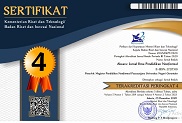The Vibrant of Harmony
Abstract
Art creation can be used to meet the needs of artists by being creative and expressing. The creative process of making this work was initiated from the creation of a figure on the object of the work of art as the artist's self-expression. This research method uses descriptive qualitative analytical and exploratory methods of data obtained from the analysis of aesthetic concepts from works of art. The problem in this process of creation is how art reaches its potential to convey the feeling of alienation of artist through the figures in the work. The results of this process of making are metaphorical figures of the process of contemplation. The message from this artwork is that art has an effective ability to evoke empathy and closeness between people who share similar experiences and complex feelings. Through figures who can reach that potential and independently make connections with appreciators
Penciptaan seni dapat dipakai untuk memenuhi kebutuhan seniman dengan berkreasi dan berekspresi. Proses kreasi pembuatan karya ini digagas dari penciptaan figure pada objek karya seni sebagai ekspresi-diri seniman. Metode penelitian ini menggunakan metode deskriptif analitik kualitatif, dan eksplorasi, data yang diperoleh dari analisis konsep-konsep estetika dari karya-karya seni rupa. Permasalahan dalam proses penciptaan ini bagaimana seni mencapai potensi untuk menyampaikan perasaan keterasingan seniman melalui figure-figure pada karya. Hasil dari proses pembuatan ini adalah figur-figur metaforik dari proses kontemplasi. Pesan yang disampaikan bahwa karya seni memiliki kemampuan efektif untukmembangkitkan empati dan kedekatan antara orang-orang yang berbagi pengalaman yang serupa dan perasaan yang kompleks. Melalui figure yang dapat mencapai potensi itu dan secara mandiri membuat koneksi dengan para apresiator
Keywords
Full Text:
PDFReferences
Balik, G., & Balık Lökçe, D. (2019). On the Relationship of Landscape and Painting. AM Journal of Art and Media Studies, 19, 29-44. https://doi.org/10.25038/am.v0i19.305
Bloch, J., & Verchère, C. (2019). How art places climate change at the heart of technological innovation. Journal of Open Innovation: Technology, Market, and Complexity, 5(4). https://doi.org/10.3390/joitmc5040093
Buckley, R. C. (2016). Aww: The Emotion of Perceiving Cuteness. Frontiers in Psychology, 0(NOV), 1740. https://doi.org/10.3389/FPSYG.2016.01740
Cheung, M. C., Law, D., Yip, J., & Wong, C. W. Y. (2019). Emotional Responses to Visual Art and Commercial Stimuli: Implications for Creativity and Aesthetics. Frontiers in Psychology, 10(JAN), 1-10. https://doi.org/10.3389/fpsyg.2019.00014
Creswell, J. W. (2014). Penelitian Kualitatif dan Desain Riset (S. Z. Qudsy (ed.); 3rd ed.). Pustaka Pelajar.
Dharsono. (2016). Kreasi Artistik perjumpaan tradisi modern dalam paradigma kekaryaan seni. Citra Sains.
Dillistone, F. (2002). The Power of Symbols (6th ed.). Kanisius.
Fiske, A. (1991). Structures of social life: The four elementary forms of human relations: Communal sharing, authority ranking, equality matching, market pricing. https://psycnet.apa.org/record/1991-97016-000
Gillies, J. (2016). Woman ' s Art Inc . The Central Figure in Botticelli ' s " Primavera ". JSTOR-Woman's Art Journal, 2(1), 12-16.
Haslam, N. (2017). Goosebumps, tears and tenderness: what it means to be moved. The Conversation. https://theconversation.com/goosebumps-tears-and-tenderness-what-it-means-to-be-moved-72545
Kabanda, P. (2016). Work as Art: Links Between Creative Work and Human Development.
Kringelbach, M. L., Stark, E. A., Alexander, C., Bornstein, M. H., & Stein, A. (2016). On Cuteness: Unlocking the Parental Brain and Beyond. Trends in Cognitive Sciences, 20(7), 545-558. https://doi.org/10.1016/J.TICS.2016.05.003
Lorenz, K. (1943). Die angeborenen Formen möglicher Erfahrung. Zeitschrift Für Tierpsychologie, 5(2), 235-409. https://doi.org/10.1111/J.1439-0310.1943.TB00655.X
Marder, L. (2019). Ways of Defining Art. ThoughtCo.
Marianto, M. (2017). Art & Life Force In A Quantum Perspective. Scritto Books.
Martopo, H. (2006). Paradigma Baru Penelitian Seni (The New Paradigm of Arts Research). Harmonia Journal of Arts Research and Education, 7(3). https://doi.org/10.15294/harmonia.v7i3.737
Rohidi, T. R., & Sabana, S. (2015). Seni grafis sebagai ekspresi budaya dan jejak teraannya dalam kancah seni rupa dan pendidikan seni di indonesia. Imajinasi, IX(2), 79-88.
Saldaña, J. (2013). The Coding Manual for Qualitative Researchers. In J. Seaman (Ed.), Qualitative Research in Organizations and Management: An International Journal (Second edi, Vol. 12, Issue 2). SAGE Publisher. https://doi.org/10.1108/qrom-08-2016-1408
Stcherbatcheff, B. (2020). These artists have found creative ways to offer hope amid the COVID-19 crisis. World Economic Forum.
Suhaya. (2016). Pendidikan seni sebagai penunjang kreatifitas. Jurnal Pendidikan Dan Kajian Seni, 1(1), 1-15.
Sulasmi, D. W. . (2002). Warna : Teori dan Kreativitas Penggunanya. ITB.
Sumarjo, J. (2014). Estetika Paradoks. Kelir.
Tabrani, P. (2014). Proses Kreasi-Gambar Anak-Proses Belajar (1st ed.). Erlangga.
Taylor, S. J., Bogdan, R., & DeVault, M. L. (2016). Qualitative Reseach Methods (4th Editio). John Wiley & Sons, Inc.
Thohari, A. (2018). Eksploitasi terhadap binatang sebagai sumber inspirasi penciptaan karya seni lukis.
Titi Andaryani, E. (2016). Proses Terjadinya Suatu Karya Seni. Imaji, 14(2), 157-163. https://doi.org/10.21831/imaji.v14i2.12179
DOI: http://dx.doi.org/10.37905/aksara.8.1.187-194.2022
Refbacks
- There are currently no refbacks.
Copyright (c) 2022 Aksara: Jurnal Ilmu Pendidikan Nonformal

This work is licensed under a Creative Commons Attribution-ShareAlike 4.0 International License.
Publisher:
Magister Pendidikan Nonformal Pascasarjana Universitas Negeri Gorontalo
Jl. Soedirman No. 06 Gorontalo 96128 e-mail: jurnalaksara@ung.ac.id
http://ejurnal.pps.ung.ac.id







